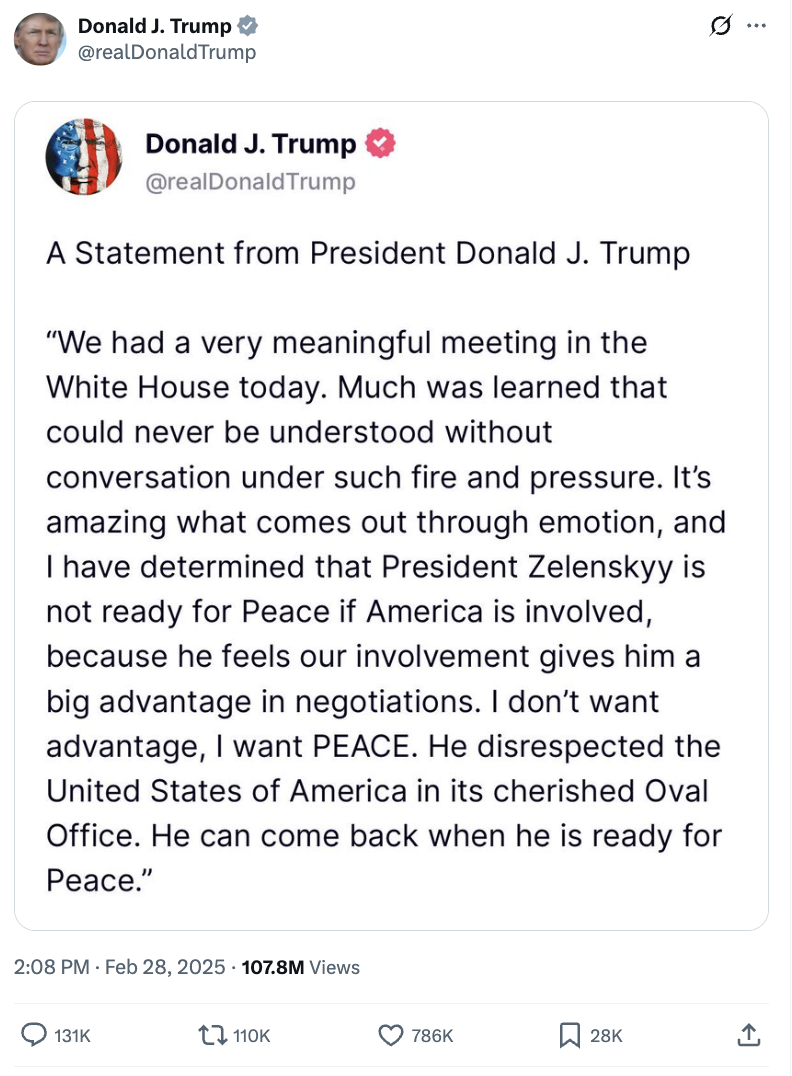Trump’s Triple War: Ukraine, Tariffs, and the Social Security Fraud
What has President Trump said this week?
〰️
What has President Trump said this week? 〰️
1. Tariffs Imposed, Delayed, Not Delayed—Then Delayed Again?
On Monday, March 3rd, President Trump said there was “no room for delay” in imposing tariffs on imports from Mexico and Canada, despite having postponed them for a month. The following day, during his State of the Union address, he declared that the United States “will take in trillions and trillions of dollars and create jobs like we have never seen before” through the new tariffs. However, studies show that these tariffs are ultimately paid by U.S. importers and passed on to American consumers, contributing to inflation.
The impact on jobs remains uncertain. Many U.S. industries, particularly the auto sector, rely on supply chains connected to Mexico, Canada, and China. States such as Michigan, Indiana, and Kentucky are particularly dependent on these trade relationships (The Conversation, 2025). Tariffs would likely raise production costs, reducing output and leading to job losses. However, job creation and losses also depend on factors like investment and domestic productivity, making the long-term effects unclear.
Stock markets reacted negatively, with renewed fears of a broader trade war driving declines on Tuesday as the long-threatened tariffs took effect. Since November 6—the day after the election—approximately $3 trillion in market value has been erased, according to Bloomberg. In retaliation, Canada imposed 25% tariffs on over $100 billion worth of U.S. goods, while China introduced 20% duties on U.S. agricultural products. Mexico announced it would reveal its response on Sunday.
On March 5th, tariffs on auto imports were delayed once again—for another month at least.
2. How Much Has Been Recovered from Fraudulent Activities?
During his State of the Union speech on March 4th, President Trump claimed that the Department of Government Efficiency (DOGE) had “found hundreds of billions of dollars of fraud.” However, DOGE’s official website states that the government has saved $105 billion—a figure that includes “asset sales, contract/lease cancellations and renegotiations, fraud, and improper payment deletion, grant cancellations, interest savings, programmatic changes, regulatory savings, and workforce reductions.” (DOGE, 2025).
Despite this claim, DOGE acknowledges that documentation to support the $105 billion figure is still being uploaded, with only about 30% currently available. Errors have already been identified in the count, including incorrect contracts and cancellations from previous administrations (CNN Politics, 2025).
Trump and Elon Musk have both asserted—without much evidence—that rampant fraud exists within the Social Security system. In his remarks, Trump claimed that government databases list millions of Social Security recipients with improbable ages, including 1.3 million people between 150 and 159 years old and more than 130,000 people over 160. “Believe it or not, government databases list 4.7 million Social Security members, people aged 100 to 109 years old” (NPR, 2025).
3. Does Ukraine Really Want World War III?
On February 28th, President Trump and Vice President Vance met at the White House with Ukrainian President Volodymyr Zelenskyy—a meeting that Zelenskyy later described as “regrettable.” During the discussion, President Trump accused Zelenskyy of “gambling with World War III” after the Ukrainian leader initially refused to agree to a ceasefire. While Zelenskyy maintains that Ukraine is willing to negotiate peace but only under its own terms, Trump later reinforced his stance in a statement posted on X:
Zelenskyy may have valid reasons for rejecting a ceasefire, as Russia has not shown serious intent for lasting peace. Even if it agrees, Russia could use the pause to regroup and launch another attack. After all, Ukraine risks losing occupied territories permanently if current frontlines become fixed.
A few days after the meeting, President Trump halted all military aid to Ukraine and President Zelenskyy agreed to a partial ceasefire.


